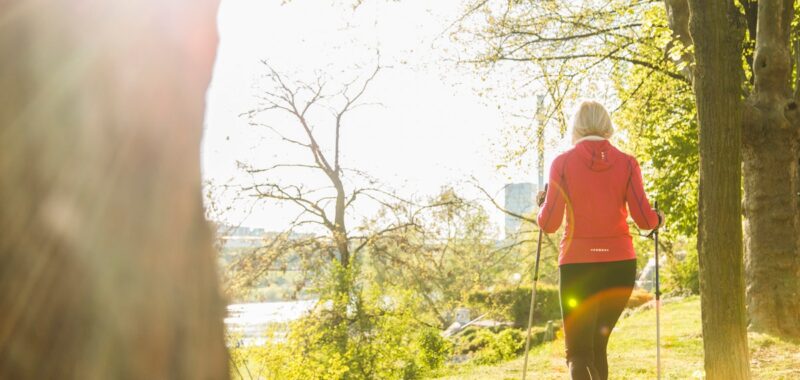You’re in your mid-to-late-30s, feeling relatively healthy, and not really thinking much about the future of your mom brain and mom bod. But should you be? As a parent, your concerns usually revolve around your kids: your baby’s milestones and behaviors, your tween’s eating habits, or those mysterious bruises your toddler always seems to have. You know what they say, though — you can’t pour from an empty cup. It’s time to focus on yourself, too! And one easy way to do that is through a health trend making the rounds on TikTok: Nordic walking.
You’re probably wondering, WTF is that? Well, if you’ve ever seen the eccentric guy from two streets over loping down the sidewalk wielding giant poles in his hands, you can bet he was probably Nordic walking. Don’t worry; you can absolutely partake in this exercise without the shiny sticks. It’s easy, accessible, and per multiple studies and healthcare professionals, Nordic walking is good for physical and mental health.
Here’s the full rundown.
What is Nordic walking, exactly?
According to the International Nordic Walking Federation or INWA (yep, that’s totally a thing), nordic walking is “a form of physical activity where regular, natural walking is enhanced by the addition of the active us of a pair of specially-designed Nordic walking poles.”
You don’t have to use the poles, though. As the INWA explains, the focus is primarily on maintaining correct body alignment and posture while engaging both large and small muscle groups in rhythmic and dynamic movements.
Did your parents have an OG NordicTrack Skier in the ’90s? It’s kind of the same idea!
In one of the many videos about Nordic walking on TikTok, Dr. Abbie Jones just pulls a stick from her yard — and it’s not even the full length you’d expect from a walking stick. She says just the act of holding something is good enough.
“So walking, in general? First, you’ve got your spinal cord activated, like at the very base levels,” Jones explains. “You’ve got your cerebellum responsible for balance and coordination. You’ve got your motor cortex. When you pull in [holding something in your hands], you’re talking about more fine motor control. You’re talking about wrist strength. You’re talking about overall physical and mental health.”
What makes Nordic walking so beneficial?
The INWA lists numerous physical benefits to Nordic walking: symmetrical and complete training of the whole body, highly effective aerobic conditioning, increased blood circulation and metabolism, and more.
But as Jones points out, Nordic walking is also excellent for your brain.
“If you are worried about cognitive decline or just generally wanna keep your brain healthy, every single day you should be engaging your walking muscles, your brain power muscles, and your grip strength. Why? Because any good cognitive intervention engages multiple areas of the brain at one time.”
What makes this different from good ole garden-variety walking?
As Jones explains, “Nordic walking engages your arms and shoulders way more than regular walking does. And it increases your grip strength. Grip strength has long been researched to be a predictor of cognitive decline in older adults.”
It’s overall more effective than regular walking and engages most of your muscles in a way that regular walking doesn’t.
OK, sold. How do I get started?
If you really want to go all in, get yourself some Nordic walking sticks and get going. But even if you’re choosing to use a stick, broom, or similar pole you might find around your house, you’re good to go as long as you think about the mental component, too.
Jones suggests doing “something, anything, that is cognitively taxing while you take a Nordic walk.” While shopping might seem like an easy answer — after all, you’re walking and holding something in your hands — you’re probably not engaging in anything cognitively taxing.
You could count backwards from 107 by 6. Or you could see how far back you can list United States presidents in order (or just list them all).
Jones uses her 72-year-old father as an example. She encourages him to pick a topic he’s interested in but knows very little about, research it the night before, and then go on a walk with someone the following day so that he can talk about everything he learned.
“That way, he’s activating his long-term memory. He is practicing a new skill. He is doing it while improving his overall physical health,” Jones explains.
She elaborates, “He is engaging multiple areas of his brain at once, causing his prefrontal cortex to talk to the motor cortex while we’re doing our Nordic walking, to talk to the cerebellum as we work on balance, to talk to the spinal cord at our basic levels of muscle movement. The synapses are firing. We’re learning something new on purpose. And we’re enjoying a nice day.”

